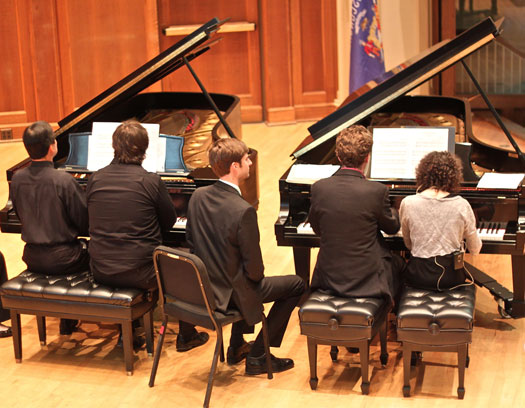In celebration of the piece’s 40th anniversary, Lawrence University musicians will give a rare performance to the day of Steve Reich’s seminal minimalist work “Music for Eighteen Musicians” Sunday, April 24 at 8 p.m. in the Lawrence Memorial Chapel. The performance, part of Lawrence’s New Music Series, is free and open to the public.
Since its premiere in New York City on April 24, 1976, this hour-long work has enchanted and mesmerized listeners. It combines subtly shifting sonorities against a background pulse that came to define Reich’s sound during the 1970s and influenced a generation of composers.
David Bowie included the piece in a list of his 25 all-time favorite albums, describing it as “Balinese gamelan music cross-dressing as minimalism.”
Instead of a traditional conductor, the piece utilizes audible and visual prompts that come mostly from the vibraphone and the bass clarinet but also other instruments as the piece progresses. This not only cues the ensemble but also teaches the audience to actively listen for the next stage of the performance.
Because of the sheer musical forces required to play the piece — four grand pianos played by six pianists and five marimba players — “Music for Eighteen Musicians” is rarely performed. When it is, the result is a musical landscape that creates a dreamlike effect and an unexpectedly joyous experience for the audience.
Despite its very mechanical structure, the piece has continued to have a profound emotional impact on audiences for four decades.
About Lawrence University
Founded in 1847, Lawrence University uniquely integrates a college of liberal arts and sciences with a nationally recognized conservatory of music, both devoted exclusively to undergraduate education. It was selected for inclusion in the book “Colleges That Change Lives: 40 Schools That Will Change the Way You Think About College” and Fiske’s Guide to Colleges 2016. Engaged learning, the development of multiple interests and community outreach are central to the Lawrence experience. Lawrence draws its 1,500 students from nearly every state and more than 50 countries.